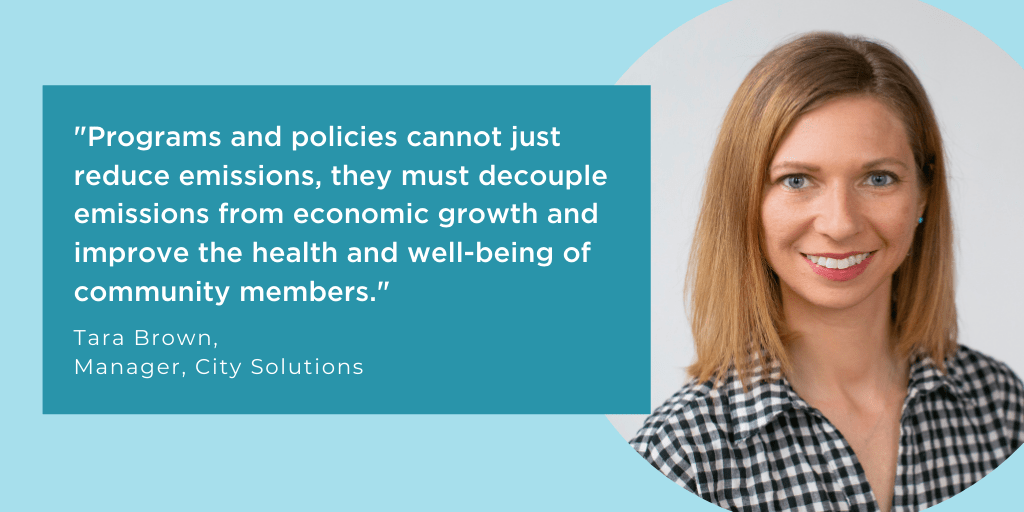IMT helps cities enjoy the economic, environmental, and social benefits of high-performing buildings through building performance policies that create healthy and resilient communities. Collaborating with building owners, tenants, governments, and other city and corporate stakeholders, as well as NGOs and strategic partners, IMT’s expert staff strive to catalyze collective and permanent market change in the built environment. So, who is IMT? Get to know our staff in this blog series.
In this Q&A, Tara Brown, IMT’s Manager of City Solutions, shares why she’s excited to support cities in reducing their emissions in a way that also supports local communities.

Was there a defining moment when the reality of climate change became personal to you? How does your current work at IMT address some of these climate challenges?
While I took personal action, my early career was not focused on climate change solutions. Later, I had the opportunity to be a part of a corporate sustainability team where I could work across the value chain to identify barriers and collectively address issues to make our products more sustainable. Our work raised the bar for transparency—the work was transformational, but it wasn’t directly related to climate emissions. I saw the commitments and work happening in cities to measure and address greenhouse (GHG) emissions which then compelled me to make a career move to city work and serve that community.
My work around climate change has been a slow build until the Intergovernmental Panel on Climate Change (IPCC) report in 2018, which underlined how urgent it is for us to make drastic changes to the way we live. In the report, the panel laid out that limiting global warming to 1.5°C would require rapid, far-reaching and unprecedented changes in all aspects of society. With clear benefits to people and natural ecosystems, limiting global warming to 1.5°C compared to 2°C could go hand in hand with ensuring a more sustainable and equitable society. I also learned that in the U.S., buildings make up 40% of our energy use and up to 30% of the energy used is wasted. This statistic has led me to my current work at IMT, where I get to address how buildings are built and operated in order to reduce energy use and their impact on our environment.
Why is diversity so important to IMT and the impact of our broader work?
Diversity challenges us as individuals and as a group—it enhances creativity and it leads to better decision-making processes and problem solving that challenges us to look at things from a different perspective. Through diversity, we understand and see the world in broader terms than just our own. When IMT collaborates with cities, we ensure a diverse set of stakeholders are engaged in the development and implementation of new policies and programs so that we understand the needs and desires of the local community as we make policy recommendations. For example, IMT’s model ordinance for building performance standards (BPS) encourages ordinance provisions that result in equitable outcomes. Collaboratively, stakeholders can design a broader set of solutions and feel a sense of investment in the solutions to building emissions and implementation of building performance policies. That diversity in background and perspectives, along with collaboration, creates successful policies and programs.
What does being IMT’s new Manager of City Solutions mean to you? What fresh perspectives do you bring to IMT’s public sector work?
Before coming to IMT, I spent time in the private sector at a Fortune 100 company working on corporate sustainability strategy and then I spent time working at a city supporting their work to reduce emissions. While working for a large corporation, the sustainability efforts were tied to the industry and across the value chain to make transformational change. As I transitioned to city work, I learned that cities have a more direct obligation to figure out how to address the emissions that they’re generating, but they can’t do this work alone. Cities need collaboration with businesses—both big and small—and community members to tackle emissions in a way that continues to support local economies as well as the community members that keep those businesses alive. These types of private-public partnerships are a key part of taking action against climate change and is one of the reasons why I’m excited about our building performance work. The foundation of this work is the same throughout any city: making sure buildings serve the people and surrounding community.
Cities are also where we’re doing the heavy lifting to drastically reduce our emissions. It’s where most of our emissions are coming from and it’s crucial that we find and test new ideas for addressing this challenge. I’m excited about this position because I believe that cities have an obligation to ensure that their community is thriving while reducing emissions—which means they have to think long-term and find ways to stack benefits through their policies and programs. Programs and policies cannot just reduce emissions, they must decouple emissions from economic growth, and improve the health and well-being of community members. This work cannot be done in a vacuum—it takes the effort of many institutions and organizations to problem-solve and I enjoy finding ways to meet multiple goals and translating complex concepts to decisions makers.
Why are cities key players in the adoption of high-performing buildings? What influence do local governments have in market transformation and climate action?
Cities are key players because they have the means to address local market failures and encourage faster adoption of high-performing buildings for all members of their communities. Cities already influence this adoption through building codes and compliance, approval of land-use, engaging with utilities to ensure future plans account and incent for new technology, supporting the private sector through financing options like Property Assessed Clean Energy (PACE), and how they manage their own buildings and infrastructure. In the past, cities viewed buildings as commodities and managed their regulation in a siloed way; such as reviewing buildings for aesthetics and meeting the minimum for health and safety code. Seeing buildings as assets that can support grid flexibility and become more resilient in the face of climate change can support the paradigm shift to utilize current policy levers and programs in a dynamic way that leads to even greater adoption of high performance-buildings.
What has COVID-19 or the ongoing social justice movements revealed to you about the building efficiency sector? What would you like to see change?
Buildings are the most visible parts of many communities, but they are frequently owned by non-residents that don’t understand local needs and concerns. This presented a problem when assessing who was at the table to give input into building performance policies. Typical stakeholder engagement included some decision makers like building owners, but not residents or community members who work in, play in, and call these buildings home. As we examine the way that we use buildings, we also have an opportunity to deepen our understanding of the intersection between housing, buildings, and systemic racism, and ensure that going forward, the people at the table and the policies proposed also promote our health and the existence of inclusive spaces within our communities.
COVID-19 has also emphasized that our health is interconnected with our buildings. From our day-to-day lives to an ongoing pandemic, buildings have the potential to keep us safe and healthy if we take the necessary steps to increase their benefits. At IMT, not only are we broadening the definition of building performance to include factors like health, we’re also bringing a variety of experts to the table to discuss policy approaches to building performance. For this reason, I’m looking forward to sharing IMT’s social issue briefs, which will support policymakers in creating equitable building performance standards. Stay tuned!

